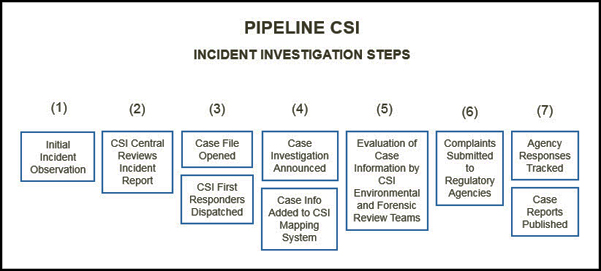The Pipeline CSI will investigate and follow-up on reported incidents of both downstream surface water impact and noncompliance with construction requirements in areas of direct disturbance, including the pipeline corridor, access roads, and stream crossings. Incident follow-up by the Pipeline CSI will include confirmation, thorough documentation, and complaint submission to regulatory agencies when warranted.
Incident investigation and follow-up will involve a sequence of seven steps.

1) Initial Incident Observation
Citizen observers, working independently, with local watershed groups, or with regional volunteer stream monitoring programs, will identify water resource problems associated with pipeline construction and submit incident reports directly to CSI Central or to local watershed groups or regional volunteer monitoring programs. Incident information will also be obtained through routine surveillance flights conducted by the Pipeline Air Force.
For more information on citizen reporting, see Guidance for Citizen Observers and Citizen Reporting Options.
2) CSI Central Reviews Incident Reports
CSI Central will monitor incident reports and contact report sources for additional information when needed.
3) Case File Opened; First Responders Dispatched
For significant incidents, a case file will be opened to track incident investigation and review, as well as regulatory agency performance. CSI First Responders will be dispatched, including (1) expert teams to collect evidence-grade water data and observe construction activities and (2) the Pipeline Air Force to conduct aerial surveillance and obtain high-resolution imagery.
4) Case Investigation Announced; Case Information Added to CSI Mapping System
For significant incidents, CSI Central will provide an early alert to the general public and to the responsible regulatory agencies, using pre-established agency points-of-contact and reporting formats. At the same time, information related to the investigation will be added to the online CSI Mapping System, an interactive multi-layered GIS map that provides access to information concerning pipeline infrastructure, construction plans and requirements, and environmental sensitivities. Case information added to the map will include high-resolution imagery of the construction activity and related water data.
5) Evaluation of Case Information by CSI Environmental and Forensic Review Teams
CSI experts will review case information provided through the CSI Mapping System and determine if formal complaint submission to regulatory agencies is warranted. Public access to the CSI Mapping System will allow other knowledgeable individuals and professionals with erosion and sediment control and stormwater management backgrounds to contribute to case review.
6) Complaints Submitted to Regulatory Agencies
In cases where noncompliance with construction requirements is established or implementation of required measures fails to prevent environmental harm, incident reports will be completed and submitted to the responsible regulatory agencies, including the West Virginia Department of Environmental Protection, the Virginia Department of Environmental Quality, the U.S. Forest Service, the U.S. Army Corps of Engineers, and the Federal Energy Regulatory Commission. Submitted reports will include documentation and an assessment of regulatory and statutory compliance.
7) Agency Responses Tracked; Case Reports Published
Agency response to complaints and the success of enforcement and remedial efforts will be closely monitored. In cases of ineffective enforcement or serial noncompliance, stop work orders and citizen suits or other legal challenges will be pursued. Case reports will be published to document regulatory performance and evaluate environmental harm resulting from construction of the ACP in high-risk mountain landscape.
